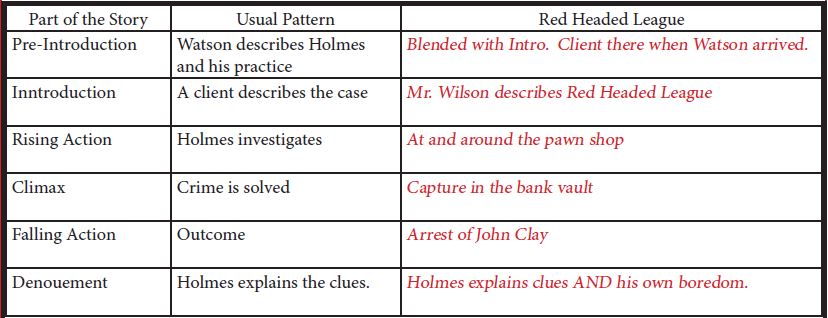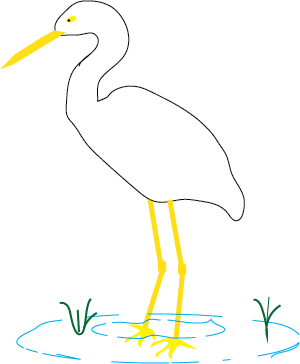Adventure of the Red Headed League
When a dull-witted client with bright-colored hair shows up with a silly story, Sherlock detects a major crime. And
readers will detect unique features of The Adventure of the Red Headed League as they analyze the literary elements of this classic fair play detective story.

- Analysis of Plot Structure
- Analysis of other literary elements
- Fun facts and background information
- Other Activities
Our Analysis of The Red Headed League
This analysis comes from Sherlock Holmes: The Unit Study. The student unit study has a variety of multiple choice questions, discussion questions, and think-it-through scenarios. On this page we only have the answers and analysis.Pre Reading Activity
Before reading the story, students were asked to look for three things:- The unfolding of the plot structure
- List clues (and red herrings)
- Watch for the philosophy of Sherlock
Analyzing the Plot of The Red-Headed League

One of the most signficant differences is that the narrative shared by their client does not include a crime. In fact, the tale told by the client in the Introduction and the crime prevented by Sherlock in the rising action and climax appear - at first - to not even be related.
Mr. Wilson's tale is silly; the crime is serious. How could the two be part of the same case? By completing the Criminal, Motivation, and Technique chart readers bring the two separate narratives together.
Fair Play Detective Story
This is considered a classic “fair play” detective story. In a fair play story, the reader and the detective know exactly the same thing at the same time. You have as good of a chance to solve it as Holmes did. This might seem a little funny considering the presented mystery and the crime are so diffferent.The teacher's notes address a common objection to this being a true fair play mystery. Sherlock tapped on the pavement and checked the knees of the assistant's trousers during the investigative phase. The reader does not know what facts Sherlock gathered through those actions. However, the fact that the reader knows he tapped the pavement and he checked the knees gives you a clue to Sherlock's reasoning. If they actually stated that the pavement produced a hollow sound and the trouser knees were soiled that would be TOO MUCH information. But knowing that he thumped the pavement and went out of his way to check the knees IS fair play.
More Literary Features
Description of the Client
Watson describes their client in these words:An average commonplace British tradesman: obese, pompous, and slow
Is he insulting all middle class people? Contrast that with the politics of today - the upper class tries to connect with the working class. (Note how politicians like to stress their parents were working class people or poor.) Could this possibly indicate snobbery of Watson and Holmes as well as Doyle? The British were much more class conscience in this era.Introductory Deductions
Here is Sherlock’s description of the same client:“Beyond the obvious facts that he has at some time done manual labour, that he takes snuff, that he is a Freemason, that he has been in China, and that he has done a considerable amount of writing lately, I can deduce nothing else.”
This is a Sherlock speciality: startling a client by analyzing their physical features and announcing their past. We consider Sherlock a genius for his ability. However, today we would scold one another for stereo-typing people for the same behavior.Holmes: An Analysis of the Man
These quotes give the readers a glimpse into the inner qualities of the brilliant detective:
I know my dear Watson that you share my love of all that is bizarre
and outside the conventions and humdrum routine of everyday life.
For strange effects and extraordinary combinations we must go to life
itself which is always far more daring that any effort of the imagination
My friend was an enthusiastic musician, being himself not only a very capable performer but a composer of no ordinary merit. All the afternoon he sat in the stalls wrapped in the most perfect happiness, gently waving his long, thin fingers in time to the music, while his gently smiling face and his languid, dreamy eyes were as unlike those of Holmes, the sleuth-hound, Holmes the relentless keen witted, ready-handed criminal agent as it was possible to conceive.
In his singular character the dual nature alternately asserted itself, and his extreme exactness and astuteness represented, as I have often thought, the reaction against the poetic and comtemplative mood which occasionally predominated in him. The swing of his nature took him from extreme languor to devouring energy; and as I knew well, he was never so truly formidable as when, for days on end, he had been lounging in his armchair among his improvisations and his black-letter editions. Then it was that the lust of the chase would suddenly come upon him, and that his brilliant reasoning power would rise to the level of intuition, until those who were unacquainted with his methods would look askance at him as on a man whose knowledge was not that of other mortals. When I saw him that afternoon so enwrapped in the music at St. Jame’s Hall I felt that an evil time might be coming upon those whom he had set himself to hunt down.
L’homme c’est rien—l’oeuvre c’est tout
It translates: “The man is nothing, the work everything.”
Fun Facts and Background Information
A Little Latin
Omne ignotum pro magnifico
Translation: Everything unknown is considered great.Can you recognize some of those words in the Latin now that you know what they mean?
Three Gilt Balls
Three gilt balls were a sign of a pawn shop. Their use dates back to the Middle Ages when the majority of the population could not read. The red and white barber pole is another example of a trade symbol.What are Improvisations and Black Letter Editions?
Lounging In His Arm Chair Among His Improvisations and His Black Letter Editions
In the vocabulary you learn these terms- Improvisations - arrangements made without forethought
- Black letter editions - black letter was a type of Medieval lettering or font that was ornamental.
Rubber Game in The Red Headed League
A rubber (also called Whist) game is a card game like Bridge played with two teams of two. It is similar to Bridge.Partie Carree
While in the underground vault, Sherwood stated to the other characters in The Red Headed League that:as we were a partie carree you might have your rubber after all
Partie Carree would be a "party square" (or party of four) in French since they sat facing each other in a square.Geography of Saxe-Colburg Square
This is a fictitious square on Farrington Street (though the street is real.)Saxe Colburg is the name of a British dynasty. It is located on Farrington Street (a north-south running street) outside of the one mile official city limits of old London but well within the London Metropolis of 1890.
Extra Activities
Just for fun let students try one of these activities:- Learn to play whist or bridge. Teach it to three others to make a square.
- Watch The Adventure of the Red Headed League with Jeremy Brett (1980s)
- Pick a topic and compare an article in The Encyclopedia Britannica with Wikipedia.


About Our Site
Hands-On Learning












